How To Add White Lines On A Water Color Painting
Painting With Watercolor
No other painting medium is quite as unique equally watercolor. Watercolor paintings are unmistakable. Fluid colors trip the light fantastic toe on the surface every bit the h2o pulls the pigment, producing delicate paintings. If desired, colors tin be layered, resulting in controlled complexity. Or colors can exist applied boldly, with broad, loose strokes, implying the subject, rather than describing it completely.
This distinctive medium is not without its share of challenges. Many detect watercolors difficult to control, and if your showtime feel with painting was with an opaque medium (oils, acrylics, or tempera), the process of watercolor painting can feel "backwards".
My Very Best Tips For Painting with Watercolors...
#1 - Utilize Quality Paints
Quality matters. The materials that you utilize greatly influence the results that you tin can expect. Many artists make up one's mind to purchase cheaper brands in order to "see if they like it", earlier committing a few more dollars to higher quality paints. While this is a skillful approach to some mediums, watercolor is different. There is a wide spectrum of quality.
Using lower quality materials inevitably leads to lower quality results. Lower quality results oftentimes lead to frustration. Information technology is wise to spend a little more on the higher quality paints in guild to give your experience with watercolor a "fair chance".
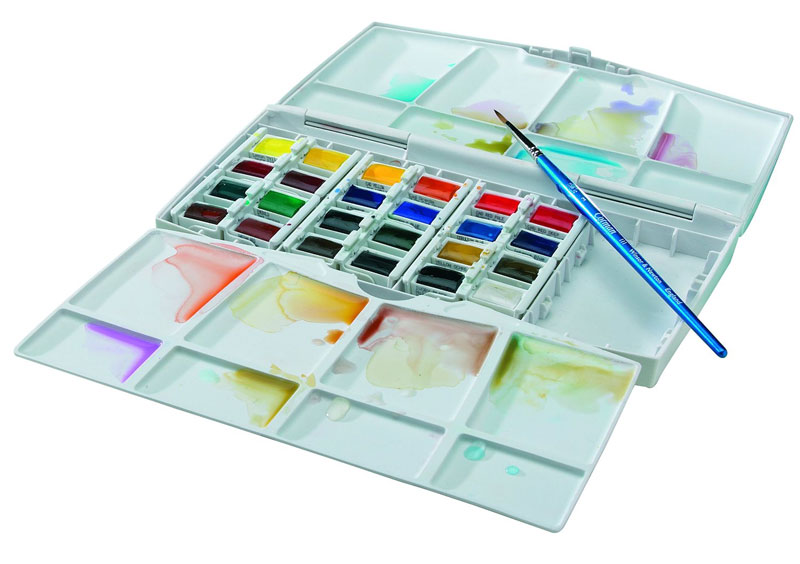
For beginners, I recommend Winsor & Newton Cotman Watercolors. They are available in cake (or pan) sets or as tube sets. Tube colors provide the artist with more than colour intensity, while cake sets are easier to travel with.
#2 - Employ The Correct Newspaper
The surface in which watercolor is practical is extremely important. Surfaces must be water-absorbent and capable of accepting multiple washes of color. This ways that appropriate papers and surfaces are typically heavier.
The weight of the paper refers to the weight of one ream of newspaper (500 sheets). The heavier the paper, the better suited it is for watercolor applications. I recommend using paper that is at least 140 lb. (300 gms). You lot can usually find this information clearly labeled on the forepart page of a pad.
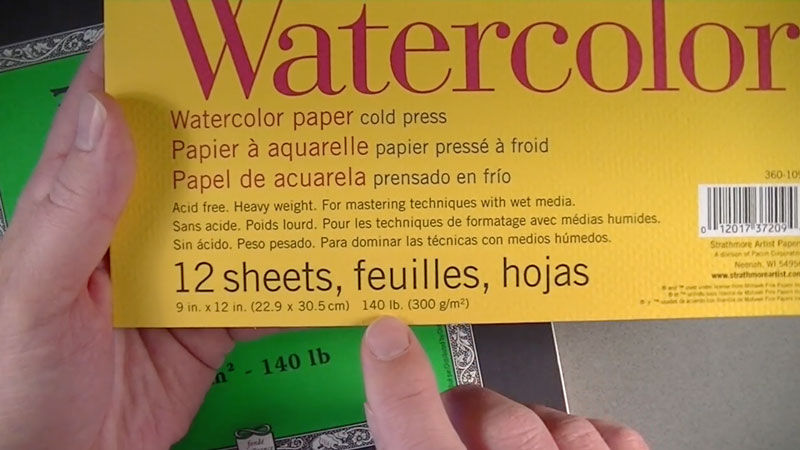
Private sheets of newspaper are likewise bachelor and are commonly watermarked. While some fence which side of the paper is all-time for utilise, I have found that information technology really is a personal choice and either side volition produce quality results.
Watercolor papers are produced as cold printing, hot press, or rough. These designations refer to the process used to make the paper. Cold press papers are pressed on common cold cylinders. Hot press papers are pressed on hot cylinders. Crude papers are pressed without the utilize of cylinders.
The texture or tooth of the paper is affected past the procedure. Hot press papers are polish, while common cold press papers have a well-divers tooth. Rough papers, equally the proper noun implies, feature the strongest texture.
If the wrong paper is used, buckling tin can occur. While many manufacturers produce papers that are labeled as "watercolor newspaper", using this paper does not guarantee that the paper will not buckle. The best indicator is the weight of the paper. The paper pictured below is labeled every bit "watercolor newspaper", only volition buckle when watercolor is applied. As you lot tin can see, the weight of the paper is simply 108.one lbs. (160 gms).
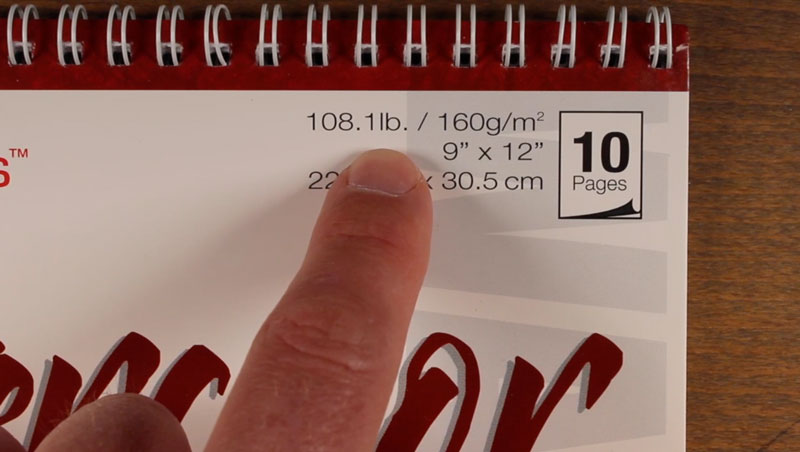
More than on watercolor papers tin can be found here.
#3 - Stretch Your Watercolor Paper
Watercolor newspaper can be stretched to better absorb washes of color. Stretching your paper ensures a taut surface. Larger papers can be soaked in a bath of h2o, and while damp, adhered to a hard board. Staples or heavy tape tin be used to adhere the newspaper. As the paper dries, it slightly shrinks, producing a suitable surface for painting.
Smaller papers tin be just adhered to a board using masking or paper tape and and so lightly done with water.
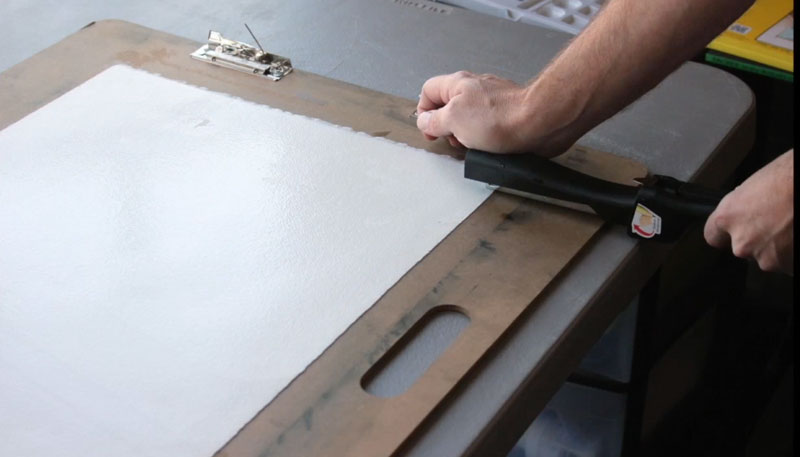
#4 - Draw Lightly
It's mutual practice to sketch the composition before painting begins. While some artists do not mind seeing the graphite marks through the painting, others adopt to accept them covered completely by the watercolor applications.
In lodge to ensure that graphite marks are hidden, sketch lightly with an "HB" pencil. Avoid shading and concentrate on developing the contour lines. Softer pencils (2B, 4B, etc.) volition produce lines that may be besides dark, while harder pencils (2H, 4H, etc.) may create grooves in the surface of the paper.
Graphite applications can exist gently lifted with a kneaded eraser before painting begins. But once watercolor has been added, information technology is near impossible to remove graphite marks from the surface.
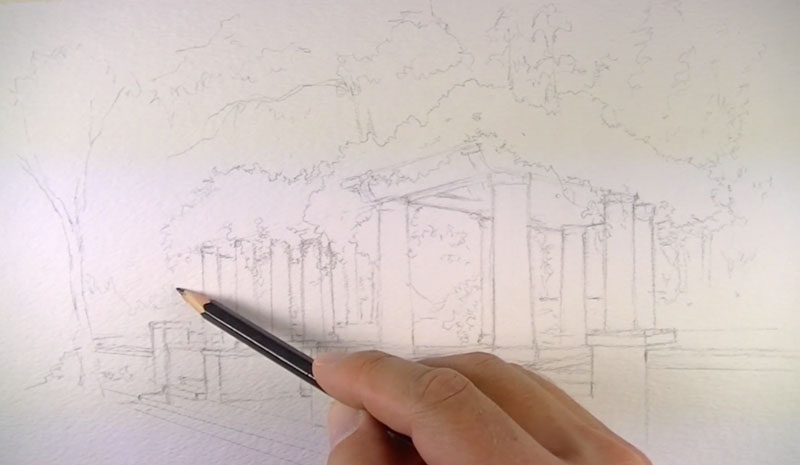
(In a higher place image from "Watercolor Landscape Series")
#5 - Utilize the Correct Brush
Brushes for watercolor panting are varied and in that location are no clear rules for which brush you should use. Nevertheless, brushes with softer bristles are typically preferred. I prefer to use synthetic brushes that are soft, nevertheless springy enough to provide control. My personal favorite are Grumbacher Golden Border watercolor brushes.
Experimentation volition often lead to finding the right castor that fits with your mode, only synthetic brushes are good identify to showtime. They are inexpensive compared to many natural hair brushes similar sable.
Stiffer brushes, like hog bristle, are generally reserved for textural furnishings and are not used for general applications.
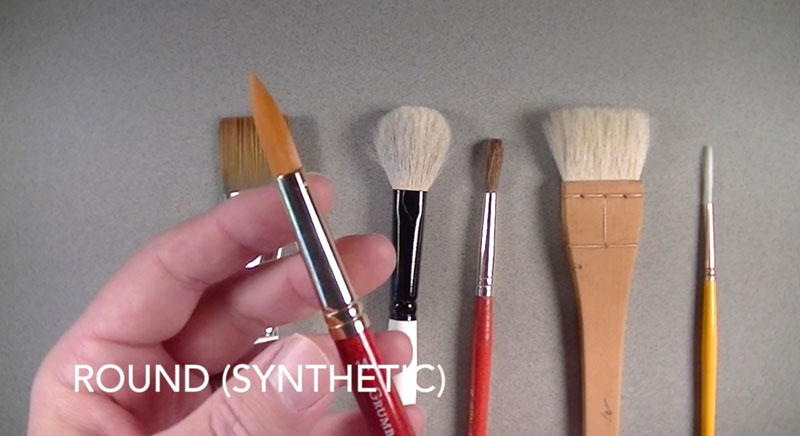
More on brushes tin be found here.
#vi - Loosen Up
Because the vehicle for applying paint is water, colors will naturally flow and form interesting shapes. It is often all-time not to fight this and instead exploit information technology. Subjects practise non need to be described completely. Shapes of color and value tin be loosely applied, implying the subject.
Allow the paint to "do what it wants" in areas and loosen upwardly with your applications. While watercolor can be used with a not bad deal of command, it's often at its most attractive when used loosely.
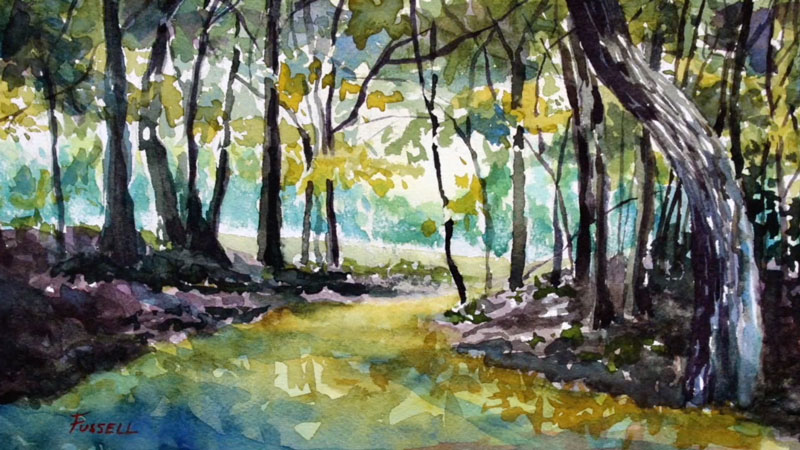
(Above image from Module eight of "The Watercolor Workshop")

#7 - Limit Your Palette
As is the example with any painting, or drawing for that matter, color theory should be considered. While information technology may be tempting to use every color that is available to yous, it'due south often best to limit your palette. Look for subjects that already accept a defined colour relationship (ie. complementary, analogous, etc.), or simplify the colors that are observed.
When your palette is simplified, the resulting painting is often harmonized and aesthetically successful.
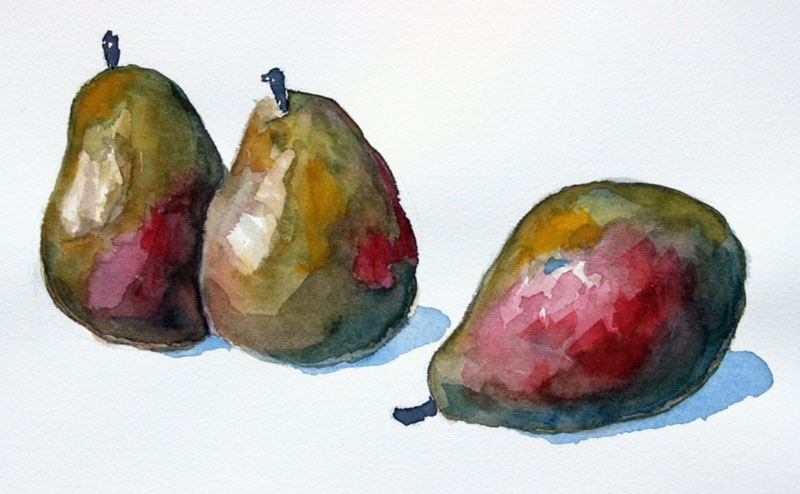
(Above image from Module six of "The Watercolor Workshop")
#8 - Layer Washes
With watercolor painting, darker values and progressively more than intense colors tin can be developed through multiple applications of color. Allowing each layer of color to dry before applying additional washes produces a glazing effect. Since colors layered underneath still bear witness though peak applications, complexity in colour is achieved.
Generally, darker values are adult further as the painting progresses. Lighter values are adult with minimal applications, since the white of the newspaper influences the resulting value.
While colors tin be mixed on the palette earlier application, optical colour mixing is also an option. Ane example is to layer a translucent application of blueish over a translucent awarding of red. The resulting colour would appear violet since the red and bluish mix optically.

(Above image from Module 13 of "The Watercolor Workshop")
#9 - Use Masking Fluid
Masking fluid is a liquid fabric that is usually latex-based. It tin be practical with a brush to protect areas in a painting from receiving washed applications. Since the white of the paper is so important in a watercolor painting, masking fluid becomes an important tool.
Once dry, masking fluid can be hands removed past rubbing with a finger or removing with an eraser. Masking fluid has a nasty addiction of ruining brushes, so it is advisable to use an old brush when applying it to the surface.
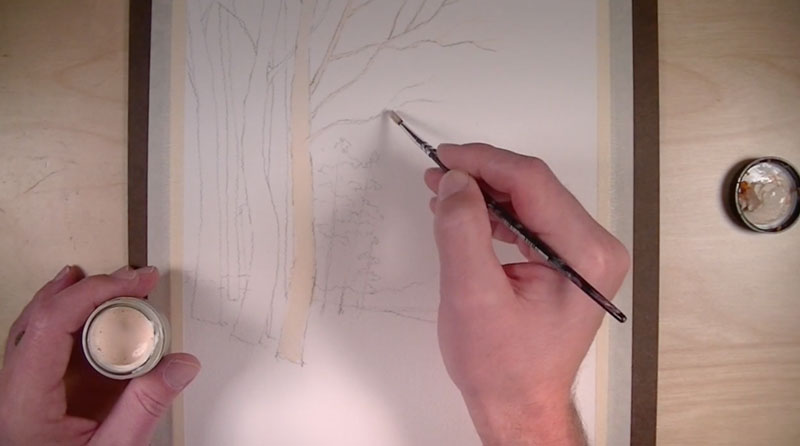
(To a higher place paradigm from Easy Watercolor Landscape)
#ten - Create a Full Range of Value
Value is perhaps the most important element of art. Value refers to the darkness or lightness of a color. It is how we see and sympathise lite, form, and texture in a flat work.
Creating a full range of value means that nosotros should include the full spectrum of darks and lights in a painting. With a colour painting, this ways that nosotros should exist sure to apply darker values of colors besides as lighter versions.
A common mistake for starting time watercolorists is to paint lightly, without a full range of value. If this applies to you, be sure to button the darker side of the value calibration to ensure that you lot are including the darkest values present on your subject or within the scene.
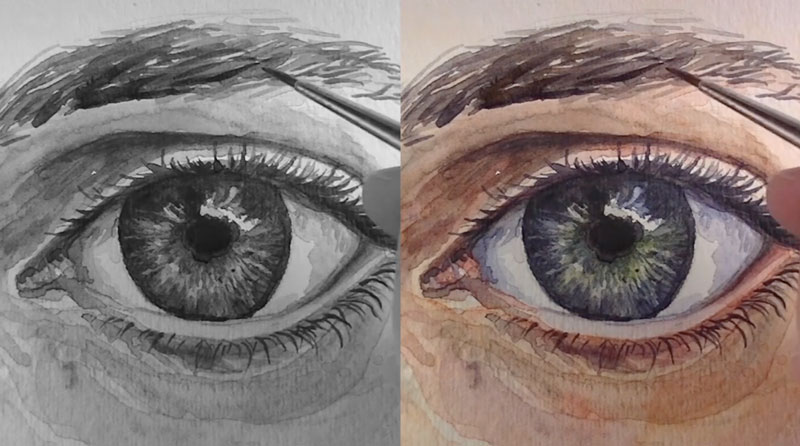
(Higher up image from How to Pigment an Eye with Watercolor)
#11 - Know When To Finish
I of the greatest challenges that an artist faces is knowing when to stop. Nosotros often find ourselves in an "creative flow", where creating is then fun that we don't want it to finish. Just if nosotros work too much, the event can appear overworked.
Unfortunately, watercolor paintings are easy to overwork and knowing when to terminate is especially of import. Knowing when a work is finished is a delicate matter without an like shooting fish in a barrel answer. Still, if yous find yourself asking "what more than can I do?", then the painting is likely finished and information technology'southward time to put down the brush. Think, every item doesn't demand to be spelled out for your viewer.
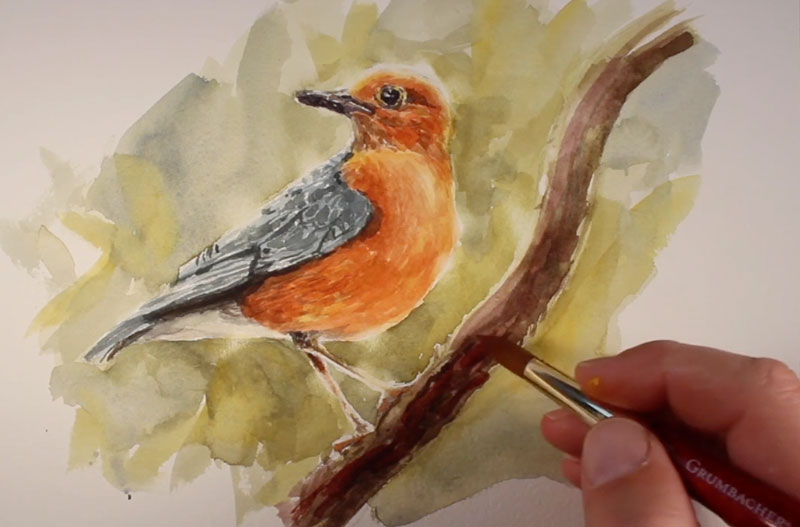
(Image to a higher place from How to Pigment a Bird with Watercolor)
#12 - Practice, Exercise, Practice
The development of skill requires do. Painting is only a skill that can exist developed by anyone with the desire. It must be recognized that this means patient do. Don't look to be an expert with your outset few attempts. With practice, you'll gradually offset edifice your confidence, and confidence is 1 of the most important aspects of watercolor painting.
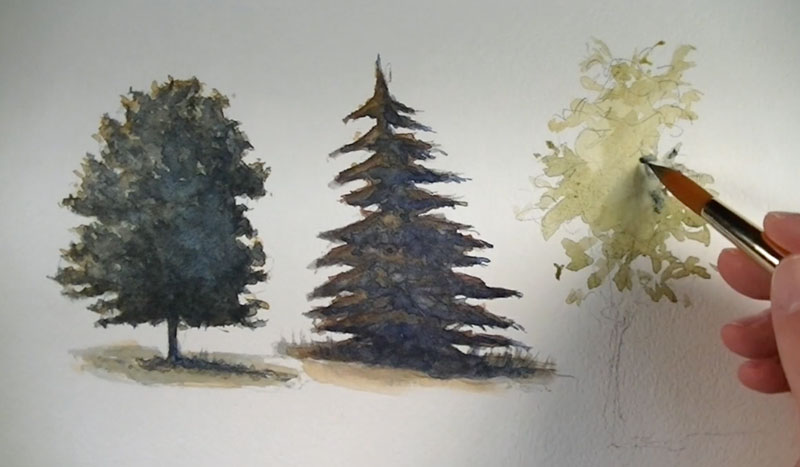
(Image above from How to Paint Copse with Watercolor)
More Lessons You'll Love...
Source: https://thevirtualinstructor.com/watercolor-painting-tips.html
Posted by: granadosguried.blogspot.com


0 Response to "How To Add White Lines On A Water Color Painting"
Post a Comment